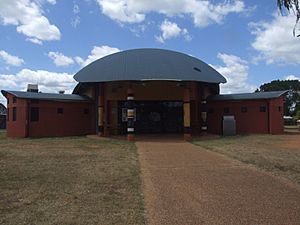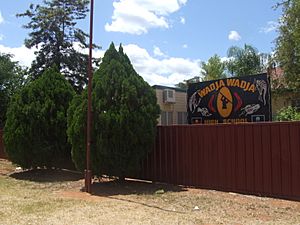Woorabinda, Queensland facts for kids
Quick facts for kids WoorabindaQueensland |
|||||||||||||||
|---|---|---|---|---|---|---|---|---|---|---|---|---|---|---|---|
 |
|||||||||||||||
| Population | 1,019 (2021 census) | ||||||||||||||
| • Density | 4.630/km2 (11.99/sq mi) | ||||||||||||||
| Established | 1927 | ||||||||||||||
| Postcode(s) | 4713 | ||||||||||||||
| Area | 220.1 km2 (85.0 sq mi) | ||||||||||||||
| Time zone | AEST (UTC+10:00) | ||||||||||||||
| Location |
|
||||||||||||||
| LGA(s) | Aboriginal Shire of Woorabinda | ||||||||||||||
| Region | Central Queensland | ||||||||||||||
| State electorate(s) | Gregory | ||||||||||||||
| Federal Division(s) | Flynn | ||||||||||||||
|
|||||||||||||||
Woorabinda /ˈwʊrəbɪndə/ is a rural town and locality in the Aboriginal Shire of Woorabinda, Queensland, Australia. It is an Aboriginal community. In the 2021 census, the locality of Woorabinda had a population of 1,019 people with 91.6% identifying as Aboriginal or Torres Strait Islander.
Contents
Geography
Woorabinda is in Central Queensland, inland about two hours' drive west of Rockhampton.
The seasonal Mimosa Creek is nearby and is a source of local water. During rainy season, the town can be isolated due to road flooding.
Access is via the Fitzroy Developmental Road, which is sealed north towards Duaringa and where it meets the Capricorn Highway to Rockhampton. To the south, it is gravel road to Bauhinia, where it meets the Dawson Highway and access to Gladstone.
East is the sealed Baralaba-Woorabinda Road, seasonally cut off by flooding. West has a number of cattle properties until the base of the Blackdown Tablelands, serviced by gravel roads.
There is also a sealed airstrip along the north road into town (24°06′51″S 149°28′35″E / 24.1141°S 149.4765°E). It is used by chartered flights and aeromedical retrieval services. No commercial flights operate to the airstrip.
History
Wadja (also known as Wadjigu, Wadya, Wadjainngo, Mandalgu, and Wadjigun) is an Australian Aboriginal language in Central Queensland. The language region includes the local government areas of the Aboriginal Shire of Woorabinda and Central Highlands Region, including the Blackdown Tablelands. the Comet River, and the Expedition Range, and the towns of Woorabinda, Springsure and Rolleston.
The town's name was chosen by Herbert Cecil Colledge, the superintendent of the settlement in 1927 using Aboriginal words, woora meaning kangaroo and binda meaning camp.
In 1926, the Queensland Government order hundreds of Aboriginal families to relocate to Woorabinda. The movement of approximately 300 Taroom residents to Woorabinda occurred most via foot over a distance of over 200 kilometres (120 mi). This walk from Taroom to Woorabinda was commemorated by the community with a supported re-enactment in 2014.
Woorabinda State School opened in 1928, closed in 1970 and subsequently reopened.
The Woorabinda community is the only DOGIT Aboriginal community within the Central Queensland region. DOGIT communities have a special type of land tenure which applies only to former Aboriginal reserves. The land title is a system of community level land trusts, owned and administered by the local council.
Cape Bedford relocation
In May 1942, during World War II, a Lutheran Aboriginal mission at Cape Bedford on Cape York in far North Queensland was closed to become used as an army camp. The relocation has also been attributed to governmental fears of Aboriginal loyalty to the German Lutheran pastor and possibly against non-Aboriginal Australian interests in favour of the Japanese. The 254 Aboriginal residents, of Guugu Yimithirr identity, were forcibly relocated; initially to Townsville via road and boat, and then via train to the ironback dormitory at Woorabinda. This trip was poorly provisioned and people arrived at their end destination having been deprived of food and blankets during the winter overland trip.
There was tension between the Cape Bedford evacuees and the residents of Woorabinda, partially due to the strong Lutheran Christian beliefs held by those from Cape Bedford. However, the evacuees also experienced many cultural experiences previously unavailable to them because of the strong church presence, such as corroborees. During this time, informal Lutheran church services and ministering were maintained by the evacuees to hold onto their Christian beliefs, creating a core strength of spiritual leadership within this group. Choral singing started during this time within the Guugu Yimithirr language from translated hymns as part of their services, which became a core part of their future church identity. They maintained a separate identity to the Woorabinda residents during the seven years they spent within the community.
Many died from sickness and exposure due to the poor sanitation and inadequate shelter from the frost and cold winter nights of the inland climate, which the Guugu Yimithirr peoples would not have previously experienced, as they were from a warm, humid coastal climate. The official number of deaths during this period was 33, but could have been up to 48. There were 13 recorded births during that time. During their time at Woorabinda, the Cape Bedford peoples experienced paid labour and schooling for the first time.
The survivors were allowed to return to Cape Bedford in 1949, after the war, to what is now known as Hopevale. Most returned north, however, a small contingent remained, which maintained a presence and link to the north which remains to this day.
Demographics
In the 2006 census, the town of Woorabinda had a population of 851 people with 94.6% identifying as Aboriginal or Torres Strait Islander.
In the 2016 census, the locality of Woorabinda had a population of 962 people with 94.7% identifying as Aboriginal or Torres Strait Islander.
In the 2021 census, the locality of Woorabinda had a population of 1,019 people with 91.6% identifying as Aboriginal or Torres Strait Islander.
Economy
In 2013, unemployment in Woorabinda was at 70%; whereas the nearby mining town of Taroom had unemployment rate of 0.7%. In 2014, Woorabinda was identified as amongst Queensland's most disadvantaged suburbs, the other five disadvantaged suburbs were also Indigenous townships.
Government service providers are the main source of employment, with local industry in the form of the takeaway cafe and Woorabinda Pastoral Company, owned by the council. The satellite Foleyvale Station is just north of Duaringa, and is included in the Woorabinda lands used pastorally.
Education
Woorabinda State School is a government primary (Prep-6) school for boys and girls at Carbine Street (24°08′11″S 149°27′22″E / 24.1365°S 149.4561°E). In 2017, the school had an enrolment of 144 students with 16 teachers and 19 non-teaching staff (13 full-time equivalent). It includes a special education program. The school motto is 'Proud and Deadly'. There is a school tuck shop which runs a paid canteen from which meals can be purchased by the community. Part of the school includes the Community Indigenous Knowledge Centre, an initiative of the State Library of Queensland, which is for access by the community.
Wadja Wadja High School is a private secondary (7–12) school for boys and girls at 116 Munns Drive (24°08′00″S 149°27′22″E / 24.1332°S 149.4560°E). In 2017, the school had an enrolment of 77 students with 4 teachers and 12 non-teaching staff (9 full-time equivalent). In 2020, there were 76 students attending the school, all of whom were Indigenous.
There is no government secondary school in Woorabinda. The nearest government secondary school is Baralaba State School (to Year 10) in Baralaba to the east; there is a school bus service. There is no nearby secondary school offering schooling to Year 12; options are distance education or boarding school.
Amenities
Woorabinda has a Knowledge Centre (library) operated by the Woorabinda Aboriginal Shire Council.
One Mob Fellowship is on Munns Drive (approx 24°08′01″S 149°27′20″E / 24.1335°S 149.4555°E). It is part of the Wesleyan Methodist Church.
Demographics
The two main groups of people in Woorabinda are the Gangulu Nation and the Wadja Nation, both of whom have Native Title claims to the land. The area claimed for the Wadja people is limited to the Woorabinda current land geography; the Gangulu nation expands as far south as Theodore, west past Blackwater, and east to Mount Morgan.
In 2008, there was a much higher proportion of people under the age of 18 in Woorabinda than in the wider non-indigenous community. Half of the population is under the age of 25, which is significantly higher than the Australian 0–24 years age group, which is one third of the population.
In the 2016 census, the locality of Woorabinda had a population of 962 people.
In the 2021 census, the locality of Woorabinda had a population of 1,019 people.
Music and dance
In 2017, the Kulgoodah dancers from Woorabinda won the Dance Rites competition, which had been founded by Rhoda Roberts. Roberts credits dance and music with having turned around the youth in the community, helping to give especially the young men "visibility and a sense of purpose". The singer-songwriter Miiesha emerged from this dance group, and in 2020 won the Best New Talent at the National Indigenous Music Awards.
Notable people
- Miiesha, ARIA Music Award-winning singer
- Reggie Cressbrook, North Queensland Cowboys NRL player
- Mick Gooda, Aboriginal activist, Australian Human Rights Commission's Aboriginal and Torres Strait Islander Social Justice Commissioner




